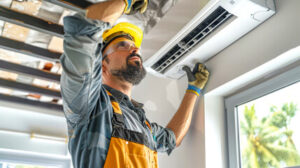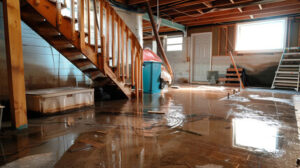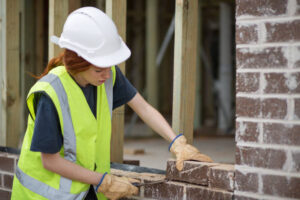If your AC system isn’t performing at peak efficiency, it can lead to high energy bills, poor indoor air quality and even health risks. Getting it repaired promptly can prevent more expensive problems down the road.

AC Repair Round Rock often involves minor and isolated issues like a clogged drain line, low refrigerant levels, or a faulty thermostat. However, it can also involve bigger repairs, such as replacing the compressor or fan.
A thermostat is the control center of your HVAC system. Its malfunctioning can put a strain on the AC and heater while increasing energy bills. The good news is that it’s often a simple repair to fix a broken thermostat.
If your thermostat display is dark or blank, even with fresh batteries and a functional circuit breaker, this is a sign that the internal components have gone bad. It may be time to call an HVAC technician for a thermostat replacement.
Thermostats typically last about 10 years, but they can begin to fail due to age, hard use, or external forces like power surges. The tiny electrical parts that send signals to the heating and cooling system can start to break down, and internal wires may become corroded or loose.
Another sign of a bad thermostat is if the supply and return vents are blowing out hot or cold air. This is usually because the thermostat is not reading room temperature correctly. The thermostat can also get dirty over time, with dust and lint blocking sensors. This can be fixed by removing the cover and cleaning it with a soft brush or cloth.
Some newer thermostats require professional installation due to complicated wiring and high-tech features. This is especially true if you have a smart thermostat that uses your home Wi-Fi to connect to your HVAC system. If you attempt to install one of these yourself, you could injure yourself or void the warranty. A trained technician will have the tools and experience needed to ensure that your thermostat is properly installed for optimal performance and reliability.
Faulty Refrigerant Levels
The cooling process in your air conditioning system depends on a chemical called Freon. If your system is low on this substance, it will not cool the air. Leaks in the refrigerant line can cause this problem, and they require professional attention to fix.
Keeping your AC well-maintained will help it run more efficiently and save you money on energy bills. A properly functioning unit also reduces the likelihood of mold growth and allergen accumulation in your home, improving indoor air quality. Regular maintenance and AC repair are also essential for extending the lifespan of your system, delaying the need for a costly replacement.
When your AC is blowing warm air, the most obvious culprit is a dirty or clogged air filter that restricts airflow and decreases the system’s ability to cool the air. Make sure that the air filter is clean and replace it as needed. Other possible causes include electrical problems, such as faulty circuit breakers or fuses, which can prevent your system from operating correctly and lead to the production of warm air. An expert technician will diagnose the issue and restore proper function.
Air leaks around doors and windows can also hinder your system’s ability to cool the air, as they allow cold air to escape and hot air to enter the home. Installing weather stripping or caulking can seal these gaps, reducing drafts and increasing cooling efficiency.
HB Home Service Team is committed to providing high-quality AC repairs to Central Pennsylvania homeowners. We offer timely services to identify and address small issues before they can turn into more expensive repair projects. Recognizing early warning signs like unusual noises or weak airflow can save you money on energy bills and ensure a comfortable summer.
Faulty Compressor
The compressor is the core component that drives refrigerant to flow between your indoor and outdoor unit, making it possible for your air conditioner to deliver cool air. If you see puddles beside your AC unit or hear rumbling, banging, clicks, growling, or screeching noises when the compressor is running, it is likely suffering from an internal issue that requires professional AC repair to resolve.
One of the most common signs of a failing AC compressor is blowing warm air. This usually occurs because the compressor is unable to pump enough refrigerant through the system. The good news is that a lack of cooling can often be solved by topping up the refrigerant levels in the compressor.
If your air conditioning system regularly trips the circuit breaker, it is likely because of electrical issues with the compressor or its fan motor. The circuit breaker is designed to trip the power to your system as soon as it detects an overload, which prevents it from becoming a fire hazard. Do not keep resetting the circuit breaker, as it could eventually damage the compressor or its components.
A rattling sound when the compressor starts up is a sign that it is struggling to turn on. This problem is not easy to fix, and you should call a HVAC professional immediately. The cause of the problem is not always obvious, but it may be a failing compressor start relay or an internal compressor failure. It is important to get the problem fixed right away to prevent further damage. A professional can replace the start relay or compressor without much trouble. If the issue is with the compressor itself, it will be more costly and time-consuming to replace.
Faulty Fan
Many people rely on their air conditioners every day. If a malfunction occurs, it can lead to discomfort, higher energy bills and potential health issues. While most major AC problems require professional attention, there are a number of minor AC repair issues that can be handled at home. This guide will help you understand how your AC works, some effective troubleshooting tips and straightforward repair techniques.
One of the most common issues affecting cooling systems is a faulty fan. This can be caused by a number of different things. If the fan isn’t spinning correctly, it can cause heat to build up inside the unit, causing the system to shut down. It may also be caused by a clogged filter that is preventing the fan from doing its job properly.
The problem may also be caused by a blown fuse or relay. If you suspect this is the case, replace the fuse or relay to restore functionality to the fan.
It’s also important to keep the area around the air conditioning unit clear. This can help prevent a number of issues, including a blocked drain line and an overheated compressor. Debris like leaves, twigs and shrubbery can impede the unit’s ability to release heat outdoors, resulting in reduced cooling efficiency and higher energy bills.
It’s also a good idea to clean the air filter regularly. This will help ensure that it’s able to do its job properly, which is to remove contaminates from the air and keep the system running at a high level of performance. Finally, it’s a good idea to change the air filter at least once per season, or more often if it is dirty.


